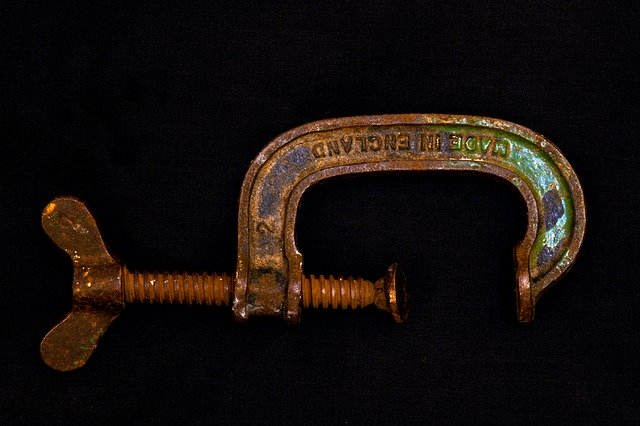Clamp and cramp

|
| A simple cast iron G-cramp (or C-cramp). |
Contents |
[edit] Introduction
A ‘clamp’ (sometimes called a ‘cramp’) is a tool (often made of cast metal) which applies a force to hold two or more objects tightly together. This may be for a temporary period after which the parts will be separated, or they will hold together without the aid of the clamp (for example if they have been glued or screwed).
The word ‘clamp’ tends to be used in engineering while ‘cramp’ tends to be used in woodworking, although to a large extent, the two terms are interchangeable.
In woodworking, a cramp may be used to hold two or more pieces of wood together for as long as it takes for an adhesive to set. Cramps can also be used to hold together assemblies temporarily (before any adhesive is applied) to see how they will fit together. They can also be used to hold small assemblies together while they are being worked on.
Structural Fixings for Ductwork Systems BG 10/2010, By Glenn Hawkins, Published by BSRIA in 2010, states: ‘Clamping occurs when forces are applied to opposing faces of a base material. In the case of a beam clamp, this creates friction and sometimes keying between the jaws or set screw of its clamp and the structural member being sandwiched. This is the operating principle of dovetail wedges used in re-entrant channels and T-head bolts used in cast-in channel systems. Tightening of the clamps to the correct torque is crucial to correct performance of these devices, as is the correct orientation of the clamps, wedges and T-head bolts.’
[edit] G- or C-Cramp
Formed in the shape of a ‘G’ (sometimes referred to as a ‘C’) these metal cramps have a screw mechanism that can be adjusted until the items in question are held tightly. The screw is turned until the object is gripped tightly between the cramp’s adjustable shoe and the cast-metal frame.
[edit] Sash cramps
These are used to clamp together large frames, for example, window frames or drawers. They comprise long metal bars with a screw-adjustable grip at one end; the other end comprises a free-moving jaw that can be adjusted to points at predetermined intervals, usually by inserting pegs into pre-drilled holes. Once the object is in position and the peg inserted into the most suitable hole, the screw end can be adjusted to grip the item firmly.
[edit] Vehicle (or car) clamp
In another application, a clamp is attached to one wheel of a vehicle in order to immobilise it, for example, until a fine is paid to the satisfaction of a parking authority. In this case, the clamp is to prevent mobility rather than to force two objects together.
[edit] Brick clamp
Short Guide: Traditional Scottish Brickwork, published, on 1 March 2014 by Historic Environment Scotland, defines clamp as: ‘A fairly crude but effective method of firing bricks in large numbers, a clamp is formed by interspersing unfired bricks and fuel.’
[edit] Bar clamps
These are versatile clamps with adjustable jaws that can be tightened or loosened to fit different sized materials. They are used for a wide range of tasks, including gluing, cutting, and clamping.
[edit] Pipe clamps
Pipe clamps are designed to clamp around pipes or other cylindrical objects. They are used for securing pipes and tubes in place during construction or maintenance work.
[edit] Spring clamps
Spring clamps use a spring-loaded mechanism to clamp materials together. They are commonly used for clamping light-duty materials such as fabrics, papers, and cardboard.
[edit] Corner clamps
Corner clamps are used for clamping two pieces of wood or other materials together at a 90-degree angle. They are often used in woodworking and cabinet making to ensure precise cuts and joints.
[edit] Bessey clamps
Bessey clamps are heavy-duty clamps that use a screw mechanism to apply pressure to clamp materials together. They are commonly used in metalworking, welding, and other industrial applications.
[edit] Related articles on Designing Buildings
Featured articles and news
RTPI leader to become new CIOB Chief Executive Officer
Dr Victoria Hills MRTPI, FICE to take over after Caroline Gumble’s departure.
Social and affordable housing, a long term plan for delivery
The “Delivering a Decade of Renewal for Social and Affordable Housing” strategy sets out future path.
A change to adoptive architecture
Effects of global weather warming on architectural detailing, material choice and human interaction.
The proposed publicly owned and backed subsidiary of Homes England, to facilitate new homes.
How big is the problem and what can we do to mitigate the effects?
Overheating guidance and tools for building designers
A number of cool guides to help with the heat.
The UK's Modern Industrial Strategy: A 10 year plan
Previous consultation criticism, current key elements and general support with some persisting reservations.
Building Safety Regulator reforms
New roles, new staff and a new fast track service pave the way for a single construction regulator.
Architectural Technologist CPDs and Communications
CIAT CPD… and how you can do it!
Cooling centres and cool spaces
Managing extreme heat in cities by directing the public to places for heat stress relief and water sources.
Winter gardens: A brief history and warm variations
Extending the season with glass in different forms and terms.
Restoring Great Yarmouth's Winter Gardens
Transforming one of the least sustainable constructions imaginable.
Construction Skills Mission Board launch sector drive
Newly formed government and industry collaboration set strategy for recruiting an additional 100,000 construction workers a year.
New Architects Code comes into effect in September 2025
ARB Architects Code of Conduct and Practice available with ongoing consultation regarding guidance.
Welsh Skills Body (Medr) launches ambitious plan
The new skills body brings together funding and regulation of tertiary education and research for the devolved nation.
Paul Gandy FCIOB announced as next CIOB President
Former Tilbury Douglas CEO takes helm.
UK Infrastructure: A 10 Year Strategy. In brief with reactions
With the National Infrastructure and Service Transformation Authority (NISTA).






















